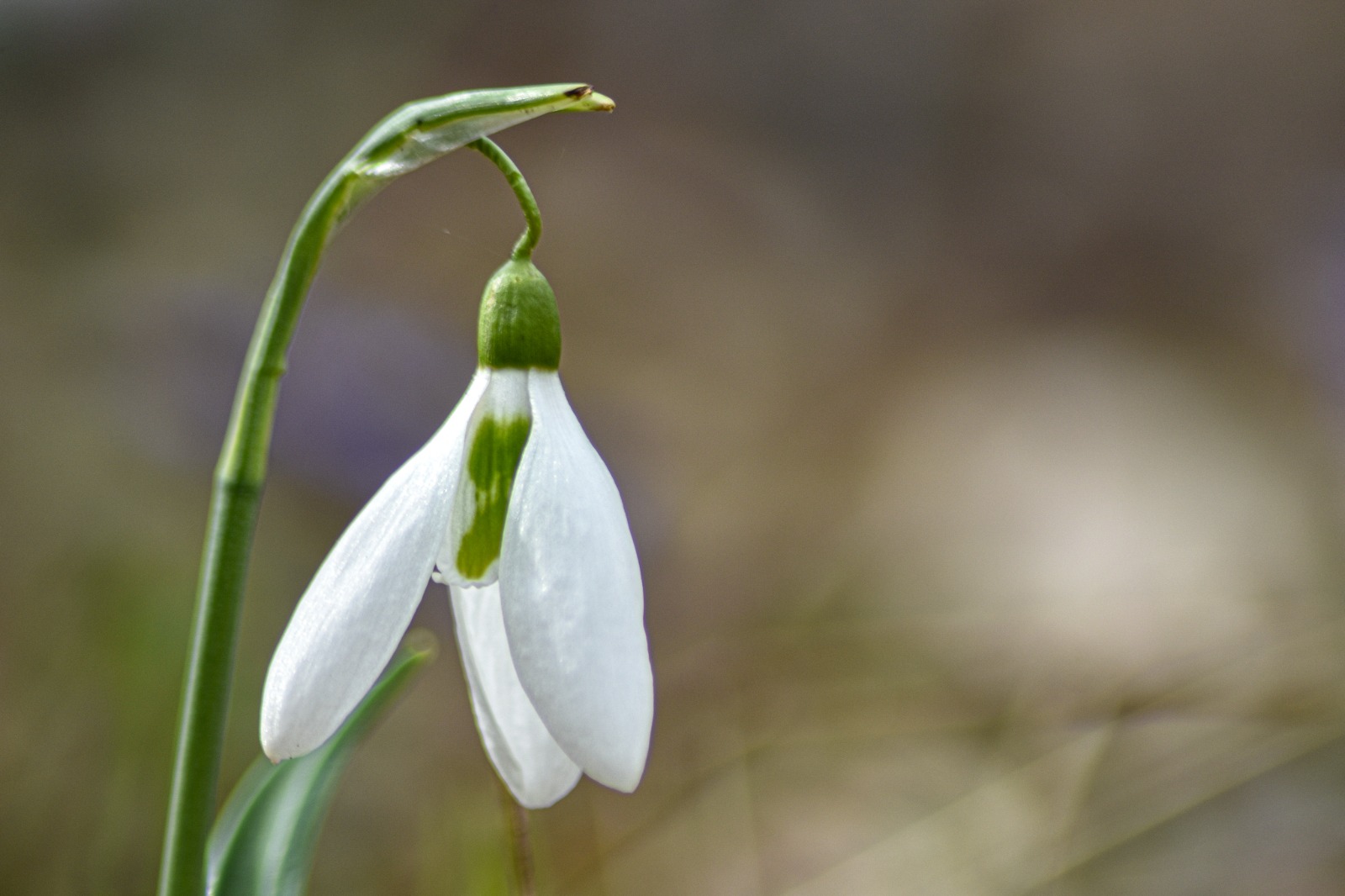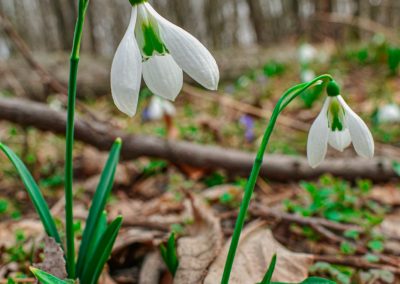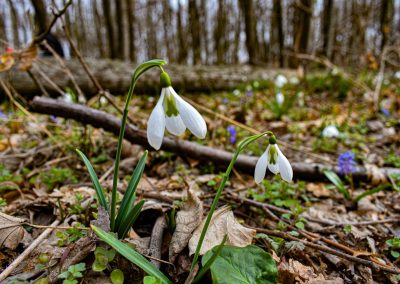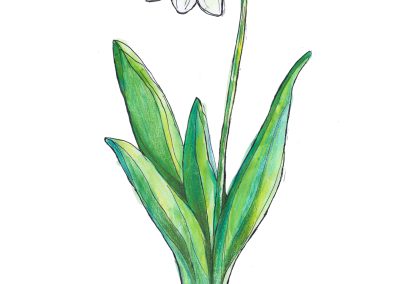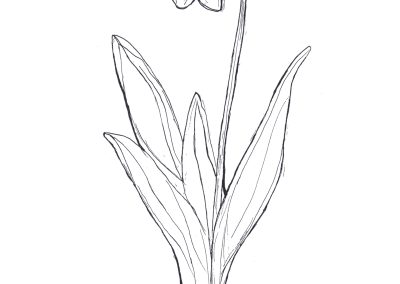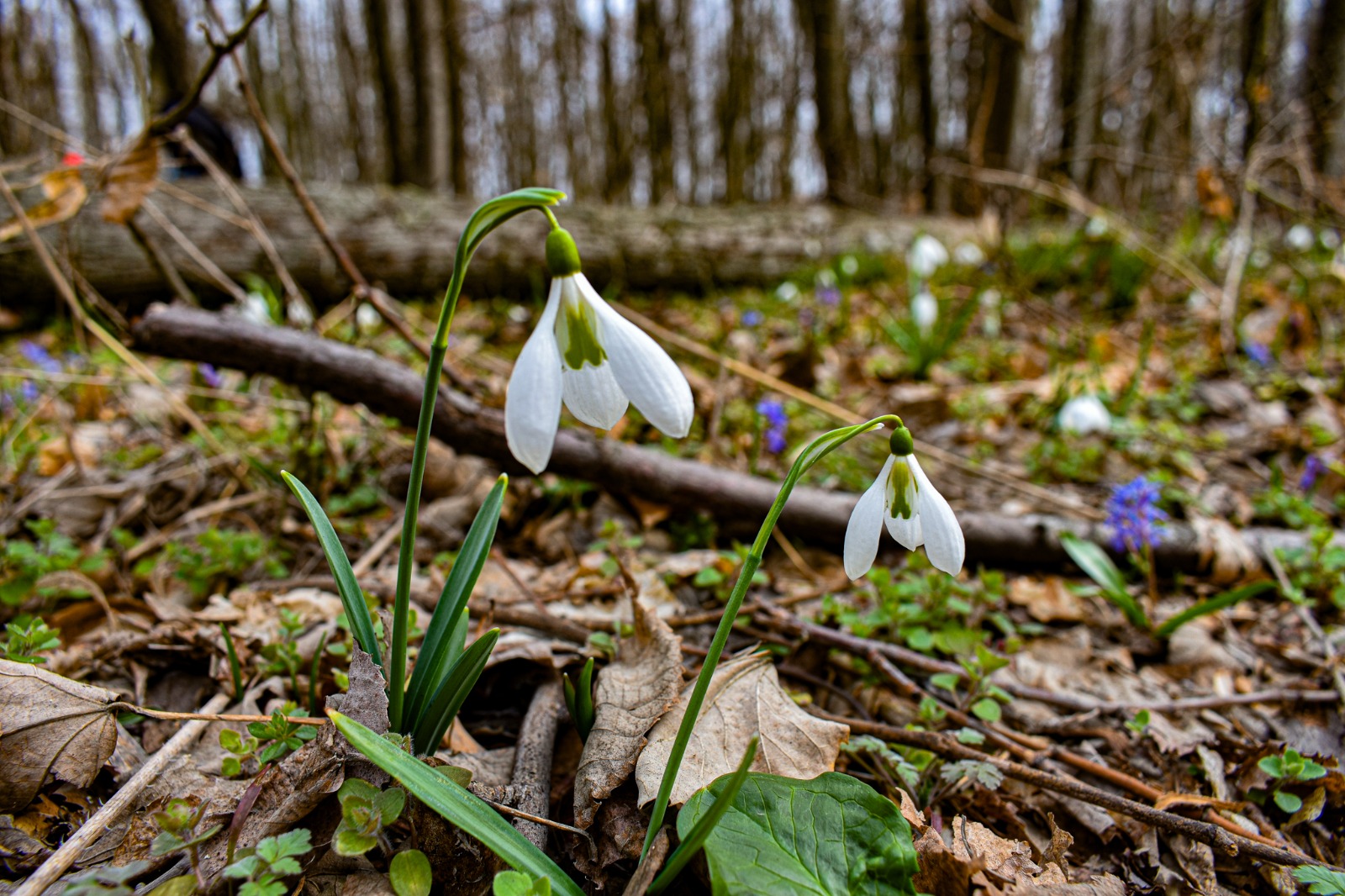Galanthus plicatus
Scientific description
Phylum: Angiospermatophyta (Magnoliophyta)
Class: Monocotyledonatae (Liliatae)
Subclass: Liliidae
Order: Liliales
Family: Amaryllidaceae
Origin: native to areas bordering the Black Sea. Floristic element Dobrogean, Basarabian, Tauric-Caucasian.
Description:
It is a herbaceous, perennial plant with globular or ovoid bulb, with brown tunics. The leaves, two in number, appear together with the flowers at the beginning of flowering, being shorter than the inflorescences; then they become larger, elongated linear, broad, dark green, at maturity about 28cm, with the central vein dividing the leaves into two parts, curved inwards. Towards the tip of the stem there is another leaf like a spathe. At the tip of the stem is a single, white, actinomorphic, hermaphrodite, nutting flower with a campanulate perigon consisting of three long, broad outer tepals and three smaller inner tepals. The flower is large and white, downward-angled, the most beautiful of the genus. The androecium consists of six stamens and the gynoecium is tricarpelar with a lower ovary. The fruit is a capsule. It flowers in March.
Propagation: by division of bulbs.
Ecology:
In our country it grows spontaneously in forests, glades, meadows, prefers humic, acidic or deeply worked calcareous soils.
Uses:
It is planted in gardens and parks as a decorative plant. Leaves and bulbs contain toxic alkaloids: leucoine and leicocitine.
Hazard: It is mentioned as rare in the Red List of higher plants in Romania (Oltean et al, 1994).
Încrengătura: Angiospermatophyta (Magnoliophyta)
Clasa: Monocotyledonatae (Liliatae)
Subclasa: Liliidae
Ordinul: Liliales
Familia: Amaryllidaceae
Origine: originară din zonele limitrofe Mării Negre. Element floristic Dobrogean, basarabean, tauric-caucazian.
Denumire populară: ghiocel plisat.
Descrierea:
Este o plantă ierboasă, perenă cu bulb globulos sau ovoidal, cu tunici brune. Frunzele, în număr de două, apar împreună cu florile la începutul înfloririi, fiind mai scurte decât inflorescențele; apoi devin mai mari, alungit liniare, late, de culoare verde închis, la maturitate de aproximativ 28 cm, cu nervura centrală ce împarte frunzele în două părți, curbate spre interior. Către vârful tulpinii se mai află o frunză ca un spat. În vârful tulpinii se află o singură floare albă, actinomorfă, hermafrodită, nutantă, cu perigon campanulat format din trei tepale externe lungi și late și trei tepale interne mai mici. Floarea este mare și albă, înclinată în jos, cea mai frumoasă a genului. Androceul este format din șase stamine, iar gineceul este tricarpelar cu ovar inferior. Fructul este o capsulă. Înflorește în luna martie.
Înmulțire: prin divizarea bulbilor.
Ecologia:
La noi în țară crește spontan prin păduri, poieni, pajiști, preferă solurile humice, acide sau calcaroase adânc lucrate.
Utilizare:
Se plantează în grădini și parcuri ca plantă decorativă. Frunzele și bulbii conțin alcaloizi toxici: leucoina și leicocitina.
Pericol: Este menționată ca rară în Lista roșie a plantelor superioare din România (Oltean et al, 1994).
Γένος: Αγγειόσπερμα (Magnoliophyta)
Κλάση: Μονοκοτυλήδονα (Liliatae)
Υποκλάση: Liliidae
Τάξη: Liliales
Οικογένεια: Amaryllidaceae
Καταγωγή: Ιθαγενές σε περιοχές που συνορεύουν με τη Μαύρη Θάλασσα – φυτογεωγραφικό στοιχείο Δοβρουτσάς, Βασαραβίας, Ταυρικού-Καυκάσου.
Κοινή ονομασία: Χιονοστάλακτος (snowdrop).
Περιγραφή:
Είναι ποώδες, πολυετές φυτό με σφαιρικό ή ωοειδές βολβό, καλυμμένο από καστανόχρωμες περιβλητικές μεμβράνες. Τα φύλλα, δύο στον αριθμό, εμφανίζονται μαζί με τα άνθη στην αρχή της άνθισης, αρχικά μικρότερα από τις ταξιανθίες, στη συνέχεια μεγαλώνουν, επιμήκη γραμμική μορφή, πλατιά, σκούρα πράσινα, μήκους έως 28 εκ. Στην κορυφή υπάρχει ένα φύλλο σαν σπάθη. Στην κορυφή του βλαστού βρίσκεται μονήρης, λευκός, ακτινόμορφος, ερμαφρόδιτος άνθος, με καμπανοειδές περίανθο (τρία μακριά και πλατιά εξωτερικά τεπάλια, τρία μικρότερα εσωτερικά). Το άνθος είναι μεγάλο και κρεμαστό. Το ανδρείο έχει έξι στήμονες και το γυναικείο μέρος είναι τρίκαρπο με υποφυή ωοθήκη. Ο καρπός είναι κάψα. Ανθίζει τον Μάρτιο.
Πολλαπλασιασμός: με διαίρεση των βολβών.
Οικολογία:
Στη χώρα μας απαντάται αυτοφυώς σε δάση, ξέφωτα, λιβάδια. Προτιμά χουμώδη, όξινα ή βαθιά καλλιεργημένα ασβεστούχα εδάφη.
Χρήσεις:
Καλλωπιστικό φυτό, φυτεύεται σε κήπους και πάρκα. Τα φύλλα και οι βολβοί περιέχουν τοξικά αλκαλοειδή: λευκοΐνη και λευκοκιτίνη.
Απειλή: Αναφέρεται ως σπάνιο είδος στην Κόκκινη Λίστα των ανώτερων φυτών της Ρουμανίας (Oltean et al., 1994).
Embranchement : Angiospermatophyta (Magnoliophyta)
Classe : Monocotyledonatae (Liliatae)
Sous-classe : Liliidae
Ordre : Liliales
Famille : Amaryllidaceae
Origine : régions bordant la Mer Noire (élément floristique : Dobrogéen, Bessarabien, Taurico-Caucasien).
Description :
Plante herbacée vivace à bulbe globuleux/ovoïde. Deux feuilles sortent avec la fleur, initialement plus courtes que l’inflorescence, puis deviennent longues, linéaires, vert foncé. Fleur blanche solitaire, hermaphrodite, pendante, à périanthe campanulé (3 tépales externes larges, 3 internes plus petits). Androcée : 6 étamines ; gynécée : tricarpellé, ovaire inférieur. Fruit : capsule. Floraison : mars.
Propagation : par division de bulbes.
Écologie :
Pousse spontanément en forêts, clairières, prairies, sols acides ou calcaires profonds.
Usages :
Plante décorative, cultivée dans les jardins et parcs. Les feuilles et bulbes contiennent des alcaloïdes toxiques : leucoine et leicocitine.
Statut : Rare en Roumanie (Liste rouge, Oltean et al).
Creative writing inspired by
Galanthus plicatus
Written by
Cristina Bianca Neacsu
Andrada-Alexandra Lica
Flowers of Love
In the heart of a quiet forest, where the trees held the world’s secrets in their bark and the wind whispered stories to those who listened, lived a young maiden named Florica. She was born on a winter’s night, when the earth lay buried under a thick blanket of snow. It was said that her arrival had been foretold by a divine force: “When the earth is at its coldest, a heart of light shall bloom.”
Florica grew up gentle and kind, drawn to the faint rays of sunlight that filtered through the bare branches. Whenever the light touched her face, her heart would stir—without knowing that high above, the Sun itself was watching her. He was a celestial spirit, guardian of warmth and life, whose heart had unknowingly been bound to the fragile girl below. Their love was silent, invisible, but strong.
Yet not all celestial spirits viewed this bond with kindness. Baba Dochia, an ancient and bitter being with a heart of stone, lived atop the ice-covered mountains. When she heard of the love between Florica and the Sun, jealousy took root in her frozen chest. She could not bear to see beauty melting her beloved snow. On a cruel winter night, when the wind howled among the cliffs and the sky was a sea of darkness, Baba Dochia descended upon the forest, casting a spell as cold as oblivion. She froze the flowers, banished the birds, and with a single poisoned breath, caused Florica’s body to collapse into the snow, drained of all life.
When the Sun saw what had happened, he descended from the sky, setting it ablaze with golden fire. He wept for her - and from his tears, where they touched the frozen ground, small, fragile flowers began to bloom. White petals, like snowflakes, but with brave little stems that pierced through the frost. These were the first snowdrops.
At dawn, the villagers emerged and saw them: tiny blossoms bowed in humility, yet full of life. “A sign from God,” the elders whispered. “A reminder of love and sacrifice.” And so the legend was born - that the snowdrop is a flower gifted by the divine to remind us that even the coldest winter cannot overcome hope. That true love, even if silent, can reach into the deepest frozen corners of the world. Since then, the snowdrop has always bloomed first. And all who see it know - with it begins the spring of the heart.


